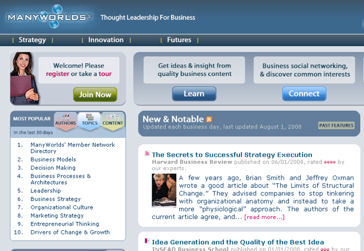Did you see 10 harsh truths about corporate websites?
It’s a great post by Paul Boag about some of the issues faced by people responsible for the corporate website in large organisations, and much of it had me nodding in agreement. If you saw it, I expect you had the same response. If you haven’t read it yet, go and do that now. I’ll wait here …
Back with me?
Here, in summary, are Paul’s 10 Harsh Truths:
- You need a separate web division
- Managing your website is a fulltime job
- Periodic redesign is not enough
- Your website cannot appeal to everyone
- You are wasting money on social networking
- Your website is not all about you
- You’re not getting enough value from your web team
- Design by committee brings death
- A CMS is not a silver bullet
- You have too much content.
Did you agree with all of those? I wonder if we agreed with the same things? Either way, it is a post likely to generate strong opinions.
I want to look at two of his 10 Truths today.
Truth #3: Periodic Redesign is Not Enough

He argues that corporate websites go through a cycle of build:gradual deterioration:redesign, with the result that every few years the company faces a significant expense, and that it would be better to go for continual investment and a gradual evolution.
And to a large extent, I agree.
Wouldn’t it be great if you could identify those relatively low-cost changes which would improve your website significantly, without having to undergo a full-on redesign? The 80:20 rule works in most cases …
On the other hand, sometimes a site has had so many incremental changes – an extra tool here, additional pages there, a whole section bolted on the side – that it has become unwieldy and needs to be stripped down and rebuilt. Just sometimes, a redesign is exactly what is needed. Either for technical reasons or for business ones: perhaps the company is rebranding, or is launching a new strategy; perhaps they’ve merged or sold off a chunk of the business. The site should serve the needs of the business, and if the business is being redesigned, so too should the site be.
However, I agree that periodic redesign isn’t enough – between these rebuilds, there should be a process of continual improvement and evolution, as the needs of the business change and new best practices in corporate communications emerge.
Truth #4: Your Website Cannot Appeal to Everyone

The target audience too often includes a long, detailed list of diverse people … and that the website should be primarily aimed at a clearly defined audience.
Unfortunately, for the corporate website, the prospective audience just is diverse.
For a retail site, you can say that the audience is – for example – teenage girls (or buyers for the teenage girls, usually their mothers). The corporate site, however, has as its primary audience a mix of:
- investors (potential and current; professional, with thousands of shares, and retail, with a handful of shares)
- analysts (investment and social responsibility)
- journalists (mainstream media – broadcasting and print – and the new media)
- job-seekers (from top to bottom of the organisation, from the inexperienced to the non-executive director, the short-term contractor to the full-time careerist)
- suppliers (of a whole range of products, services and people)
- business partners (current and prospective)
- customers (browsers, purchasers, those seeking support)
- employees (current and – sometimes – alumni).
And it has to provide information for most of those people most of the time, as well as provide additional information, perhaps about corporate governance and compliance, about its social responsibility actions, or about its subsidiary businesses, or mergers and acquisitions – even corporate messages in times of crisis.
This potential audience can be reduced, though why would you want to? How else are you going to communicate with all these different people?
Do you really want to reduce the breadth of your target audience?
There are ways of reducing the diversity of the audience; companies take different approaches to this, and this will vary by the business strategy of the company.
- Sometimes a company tries to meld its retail and corporate site together, and in that case usually the customer is seen as the primary audience, and the corporate information is hidden behind an About Us link. Others don’t address customers at all.
- Some companies don’t address suppliers on their site; most don’t address their employees. Some don’t even put information for job-seekers on their corporate sites.
- For some, business partners are all but irrelevant; for others, partnering is a significant part of the business strategy, and spelt out in full on the site.
And so the size of the potential audience can be reduced a bit, possibly, and even when you’ve done that, there still remains a wide range of interest groups, which as an absolute minimum includes investors and the media, each of which is a widely diverse group in itself. A financial print journalist may not be interested in the same material as a feature journalist or a broadcast journalist; and print journalists are not necessarily interested in the same information as a small-scale shareholder.
Is providing information for investors and journalists really more important than for the other stakeholders in the company? And scaling down the target audience in this way doesn’t take into account the required information that a company must provide on its site.
So what should those responsible for the corporate website do?

It is very difficult to say which of this assortment of interest groups should be seen as the target audience; and that is why the corporate website is almost always broken down into silos, with a section for each interest area.
That way each section can be targeted to the interests of that group, providing them with the information that they need quickly, and providing easy access for them to find information elsewhere on the site if needed.
Even so, the overall site should be consistent in appearance and message, so that the brand and strategic message of the company is conveyed effectively across the whole site.
And that brings us to an issue touched on tangentially in the list of Harsh Truths: branding, and the debate over who gets a stake in the home page territory. Prime real-estate up for grabs – and of course everyone wants a share. Imagine the committee meetings in a Harsh Truth company to decide how many pixels each should be able to fill with content … and imagine the confusion on the home page if each division were allowed to fill their 250px*250px with whatever seemed best to them.
This is where Paul’s suggestion of a Web Division with adequate resource, experience and responsibility, led by an experienced manager with real control is interesting, and brings together a number of the Harsh Truths, particularly #1. Someone has to be in charge.
But who has control of the message? Who matches up the web strategy with the corporate strategy?
None of this is easy, and leads us to Harsh Truth #11: the corporate website is more difficult to manage than you’d think.





